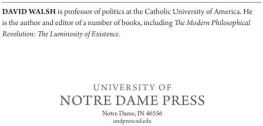Photo Credits
Introduction: DEA PICTURE LIBRARY/De Agostini/Getty Images
Chapter Three: DEA/G. DAGLI ORTI/De Agostini/Getty Images
Chapter Seven: Moviestore collection Ltd/Alamy Stock Photo
Chapter Eight: DEA/E. LESSING/De Agostini/Getty Images
Chapter Ten: Universal Images Group/Getty Images
Chapter Twelve: Josse/Leemage/Corbis Historical/Getty Images
Epilogue: Heritage Images/Hulton Fine Art Collection/Getty Images
All other images found in the public domain.
2018 by Michael Walsh
All rights reserved. No part of this publication may be reproduced, stored in a retrieval system, or transmitted, in any form or by any means, electronic, mechanical, photocopying, recording, or otherwise, without the prior written permission of Encounter Books, 900 Broadway, Suite 601, New York, New York, 10003.
First American edition published in 2018 by Encounter Books, an activity of Encounter for Culture and Education, Inc., a nonprofit, tax exempt corporation.
Encounter Books website address: www.encounterbooks.com
The paper used in this publication meets the minimum requirements of ANSI/NISO Z39.481992 (R 1997) (Permanence of Paper).
FIRST AMERICAN EDITION
LIBRARY OF CONGRESS CATALOGING-IN-PUBLICATION DATA
Names: Walsh, Michael, 1949 author.
Title: The fiery angel: art, culture, sex, politics, and the struggle for the soul of the West / by Michael Walsh.
Description: New York: Encounter Books, 2018. | Includes bibliographical references and index.
Identifiers: LCCN 2017054145 (print) | LCCN 2018007596 (ebook) | ISBN 9781594039461 (ebook)
Subjects: LCSH: ArtsPolitical aspects. | Arts and history. | Civilization, Western.
Classification: LCC NX180.P64 (ebook) | LCC NX180.P64 W45 2018 (print) | DDC 709dc23
LC record available at https://lccn.loc.gov/2017054145
Interior page design and composition: BooksByBruce.com
For Julianne Shinto
Contents
Battle of Agincourt
And yet play, players, and playing are essential to any culture: all the worlds a stage, and not only to Shakespeare. We cannot understand the nature of a people or a civilization merely by its transient politics; we must also delve into its art, myths, stories, legends, and songs.
Wanderer Above the Sea of Fog
Ah, but what narrative is contained herein? Who is this man? How did he get there? Was the ascent arduous? Did he come to find solace or release? One step farther and he must certainly plunge to his deathwhere does his next step take him?
The Raft of the Medusa
Here we arrive at the salient difference between art and propaganda. Gricaults masterpiece captures the horror and despair of the rafts victims just as the Argus heaves into view on the distant horizon. Will the ship see them? Will it arrive in time? Or will it simply sail past, oblivious?
The Visitation
The idea of the equality of the sexes in Gods eyes is a fundamentally Christian concept. Today, when the meaning of the word equality has been enlarged and expanded in the wake of the French Revolution, and then constricted and diminished again in turn by the reductive Marxist revolution, this may not seem like much. But to the womenand menof the time, it was everything.
Alexander and Aristotle Pointing at the Sky
The king expects answers; the tutor cannot quite provide them. The heavens are appealed to. The clouds lower. Neither God nor Allah nor Yahweh is heard from. Man aloneas is his duty in the Western heroic-narrative traditionmust provide the solution through the power of his reason, his instinct, his courage, and his faith. Can there be a more apt illustration of the essence of Western philosophy and ethos?
Italia und Germania
In choosing to base his idealized portrait of trans-Alpine cultural and political harmony on the familial ties between Judaism and Christianity, and turning it into a mixture of sacred and profane love, Overbeck attached a literally hidden sexual and religious subtext that was, at the same time, entirely in keeping with the principles of the Nazarene movement.
The Tennis-Court Oath
One hears echoes of Rousseaus famous dictum, Man is born free, and everywhere he is in chains, from The Social Contract of 1762, which has been the handbook of revolutionaries ever since it first appeared, opening with an epigraph from the penultimate book of Virgils Aeneid: foederis aequas Dicamus legesLet us strike an equal treaty with themand illustrating once again the long chains of political resonance that derive from works of art.
Two Men Contemplating the Moon
Is this not one of the central questions of our existence: is the news good or bad? Are the signal fires deceptive? Are the gods playing with us, arousing our hopes only to dash them again, as their whim takes them? Is it some cheat, framed by Heaven? Or have we finally encountered Truth?
Fire comes and the news is good,
It races through the streets
But is it true? Who knows?
Or just another lie from heaven?
Aeschylus, Agamemnon, from the Oresteia, 458 B.C., translation by Robert Fagles
In the name of the blessed and Holy Trinity, I do desire thee, strong and mighty angels (here name the spirits you would have appear) that if it be the divine will of him who is called Tetragrammaton, &c. the holy God, the Father, that thou take upon thee some shape as best becometh thy celestial nature, and appear to us visibly here in this place, and answer our demands, in as far as we shall not transgress the bounds of the divine mercy and goodness, by requesting unlawful knowledge; but that thou wilt graciously shew us what things are most profitable for us to know and do to the glory and honour of his divine Majesty who liveth and reigneth, world without end.
























